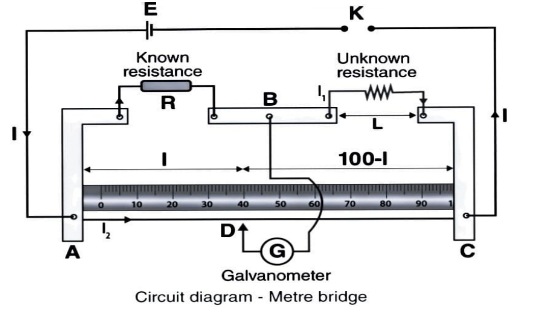
In a meter bridge experiment the resistance of the resistance box is $16\,\Omega $, which is inserted in the right gap. The null point is obtained at $36\,cm$from the left end. The least count of meter scale is $1\,mm.$ The value of unknown resistance is?
Answer
440.4k+ views
Hint:A metre bridge, also known as a sliding wire bridge, is a device that works on the Wheatstone bridge idea. It's used to figure out a conductor's unknown resistance. The experiment below shows how to use a metre bridge to estimate the resistance of a specific wire and the resistivity of its substance.
Complete step by step answer:
A slide wire bridge is another name for a metre bridge equipment. It is made out of a long wire with a uniform cross-sectional area that is fastened to the wooden block. The Wheatstone's bridge is made up of two gaps formed by thick metal strips.
Then, applying Wheatstone's principle, we have:
$\dfrac{X}{R} = \dfrac{l}{{(100 - l)}}$
We can calculate unknown resistance:
$X = R \times \dfrac{l}{{(100 - l)}}$

By using above formula:
$R = $Value of known resistance $ = 16\Omega $
$\Rightarrow l = length = 36\,cm$
For calculating unknown resistance formula:
$X = R \times \dfrac{l}{{(100 - l)}}$
$\Rightarrow X = 16 \times \dfrac{{36}}{{(100 - 36)}}$
$\Rightarrow X = 16 \times \dfrac{{36}}{{64}}$
$\therefore X = 9\Omega $
The accuracy with which a metre bridge can measure the value of current is known as its sensitivity. When all resistances are of the same order, the bridge is most responsive.
Note:Because of its high specific resistance or resistivity, manganin or eureka wire is utilised in metre bridges. Because copper is a good conductor of electricity, thick copper strips are utilised in metre bridges.
Complete step by step answer:
A slide wire bridge is another name for a metre bridge equipment. It is made out of a long wire with a uniform cross-sectional area that is fastened to the wooden block. The Wheatstone's bridge is made up of two gaps formed by thick metal strips.
Then, applying Wheatstone's principle, we have:
$\dfrac{X}{R} = \dfrac{l}{{(100 - l)}}$
We can calculate unknown resistance:
$X = R \times \dfrac{l}{{(100 - l)}}$

By using above formula:
$R = $Value of known resistance $ = 16\Omega $
$\Rightarrow l = length = 36\,cm$
For calculating unknown resistance formula:
$X = R \times \dfrac{l}{{(100 - l)}}$
$\Rightarrow X = 16 \times \dfrac{{36}}{{(100 - 36)}}$
$\Rightarrow X = 16 \times \dfrac{{36}}{{64}}$
$\therefore X = 9\Omega $
The accuracy with which a metre bridge can measure the value of current is known as its sensitivity. When all resistances are of the same order, the bridge is most responsive.
Note:Because of its high specific resistance or resistivity, manganin or eureka wire is utilised in metre bridges. Because copper is a good conductor of electricity, thick copper strips are utilised in metre bridges.
Recently Updated Pages
Master Class 12 Business Studies: Engaging Questions & Answers for Success

Master Class 12 Economics: Engaging Questions & Answers for Success

Master Class 12 English: Engaging Questions & Answers for Success

Master Class 12 Maths: Engaging Questions & Answers for Success

Master Class 12 Social Science: Engaging Questions & Answers for Success

Master Class 12 Chemistry: Engaging Questions & Answers for Success

Trending doubts
Which are the Top 10 Largest Countries of the World?

Differentiate between homogeneous and heterogeneous class 12 chemistry CBSE

Why is the cell called the structural and functional class 12 biology CBSE

When was the first election held in India a 194748 class 12 sst CBSE

What is the Full Form of PVC, PET, HDPE, LDPE, PP and PS ?

Derive an expression for electric potential at point class 12 physics CBSE




